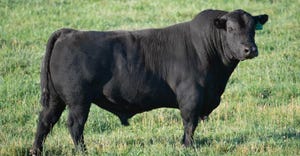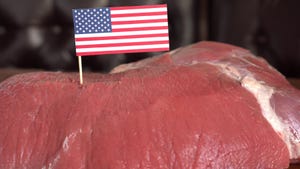Retool with Care
It is said that necessity is the mother of invention. Today, that adage is ringing true for the beef industry as higher costs and slimmer ranch margins are prompting some innovative thinking in order to survive. Colorado State University Extension range specialist Roy Roath says that more than at any time in his 30-year career, he sees ranchers ready to implement changes from moving calving dates
February 1, 2010

It is said that “necessity is the mother of invention.” Today, that adage is ringing true for the beef industry as higher costs and slimmer ranch margins are prompting some innovative thinking in order to survive.
Colorado State University Extension range specialist Roy Roath says that more than at any time in his 30-year career, he sees ranchers ready to implement changes — from moving calving dates to diversification.
“Ranch families are recognizing they can't stay in business unless they change — and they're making changes relatively quickly,” Roath says. “The driver is the need to manage costs. Doing business as usual just doesn't work anymore — there's not enough revenue.”
While Roath commends ranchers for adjusting to remain viable, he cautions them to enact changes strategically.
“Doing things in a different way needs to be well considered, and done on an informed basis with a strategic plan of how the ranch will be positioned after the change,” he says. Producers can't just make random changes and hope for the best, he adds.
So how are ranchers looking to add efficiency and enhance revenue, and what factors need to be considered? Here are three examples:
Change calving season
Jack Whittier, Colorado State University Extension beef specialist, says ranchers increasingly are recognizing that matching the physiology of the cow with the physiology of the plant is an important key to reducing costs.
“When calving season more closely matches forage growth, the cow is better able to meet her increased nutrient demand for milk production from grazing rather than from more expensive harvested feeds and supplementation,” he says.
However, he and Roath point out that there are several interacting factors a rancher must consider before moving calving dates.
For one, changing the calving season is more than just a change in breeding time. “Changing the calving season makes a profound difference on forage management. Producers need to look at the types of forage they have available, the grazing pressure on them during different seasons and determine carrying capacity,” Roath says.
With summer calving, young calves are often carried over to the following spring. This can pose some new management concerns, he says. Are you prepared to handle young calves during winter storms? Can you handle multiple herds such as cow-calf, bulls, yearling steers and heifers, as well as two-year-old cows during that timeframe? Do you have enough forage? And, will your marketing plan fit this new system?
“The benefits of price cycles by marketing calves during times when supplies are traditionally lower and prices are higher is a consideration. But the impact on cash flow must also play into the planning for such changes,” Whittier adds.
Roath adds, “Producers need to think through their contingency plan. When a new system is properly planned, it can be a benefit to the operation. If not, it can become a disaster.”
His advice to ranchers evaluating a change in calving season is to pay particular attention to available forage and carrying capacity. He suggests that leasing pasture or crop residue may be necessary.
Additionally, Roath says the increased number of management groups needs to be addressed. If you plan to keep calves over the winter, determine how you'll manage and market them. “It's important to look at flexibility,” he adds.
Run yearlings
Roath and Whittier say adding yearlings to an operation when ample forage exists can be increase revenue and spread risk.
And, they're seeing some creativity from ranchers who are trying to enhance profitability. One example is running light calves in common with yearlings, or pooling steers and heifers — or cattle and sheep — in the same pasture.
“Some of these things were unheard of in the past, but the economy is prompting producers to look at novel ways to manage herds more efficiently and profitably,” Roath says.
Here again, Roath cautions that the impact to the operation's available forage resources must be evaluated.
Fee hunting
An increased emphasis on wildlife to bring another source of revenue to the ranch is another tactic gaining momentum.
“Lots of folks have dabbled in offering hunting for a long time — and they often let friends and family do it for free,” Roath says. But today, more ranches are recognizing recreation as a viable source of revenue, and “maybe they can't afford to give it away anymore,” he adds.
Whittier emphasizes that those considering this option must be willing to deal with people. “Customer service becomes an important component of these ventures,” he says.
In addition, there are management considerations to evaluate to balance both livestock and wildlife production on the range, Roath adds.
Prepare for the future
Looking forward, these specialists believe ranch operations must continue to test strategies that reduce costs and increase revenue. Some might include:
Scale of operation
This is an increasingly critical issue, especially for ranches with fewer than 300 head of cattle and more than one family to support. Roath says, “making a profit on cattle by themselves is difficult, but making a profit for more than one family involved in an operation is another issue.” He suggests that leasing land or sharing agreements may offer alternatives to increase a ranch's scale and efficiency.
“Land prices are out of reach for many small operators, and adding additional harvested forages costs too much,” Roath says. He suggests collaborating with neighbors to lease crop residue or additional land resources.
Cooperate
Speaking of neighbors, Roath suggests finding ways for efficient cooperation.
“I get that everyone wants to run their own operation, but if you're trying to keep your heifers away from the neighbors because you're all breeding at different times, maybe it's time to find ways for working cooperatively to add efficiency to each operation,” Roath says.
Whittier adds that cooperative ventures with neighbors may help capture discounts for volume purchases of feed supplements or animal health products.
Irrigation
If you're going to purchase land, irrigated land is a better buy than rangeland because of its increased carrying capacity. “It brings diversity and flexibility to an operation,” Roath says.
Stocking rate
Finally, Roath emphasizes that proper stocking rate is critical. “When you push stocking rate up to change your scale, it increases risk and decreases flexibility. It's not an effective way to grow,” he says.
Roath adds that severe drought during the last decade in some areas has prompted more ranchers to realize that range management is critical to survival.
Roath concludes, “I think there is a future in agriculture, but only if producers are willing to change with the times.” That means managing costs, increasing the scale of the operation and diversification.
In addition, he advises ranchers to scrutinize their labor, management, forage resources, economic resources and marketing strategies. Now more than ever, “Ranchers have to think through and link all those facets,” he says.
Kindra Gordon is a freelance writer based in Whitewood, SD.
Resources
More ideas
Managing invasive species, open space, sustainable livestock production, drought and resource conservation are topics to be discussed Feb. 7-11 during the joint annual meeting of the Society for Range Management and the Weed Science Society of America in Denver, CO.
Featured will be experts in range ecology, watershed management, livestock production and natural resource management, as well as ranchers telling their success stories. A special program on managing open space in urban and suburban environments is also offered.
For more information, visit www.rangelands.org.
You May Also Like

.png?width=300&auto=webp&quality=80&disable=upscale)

